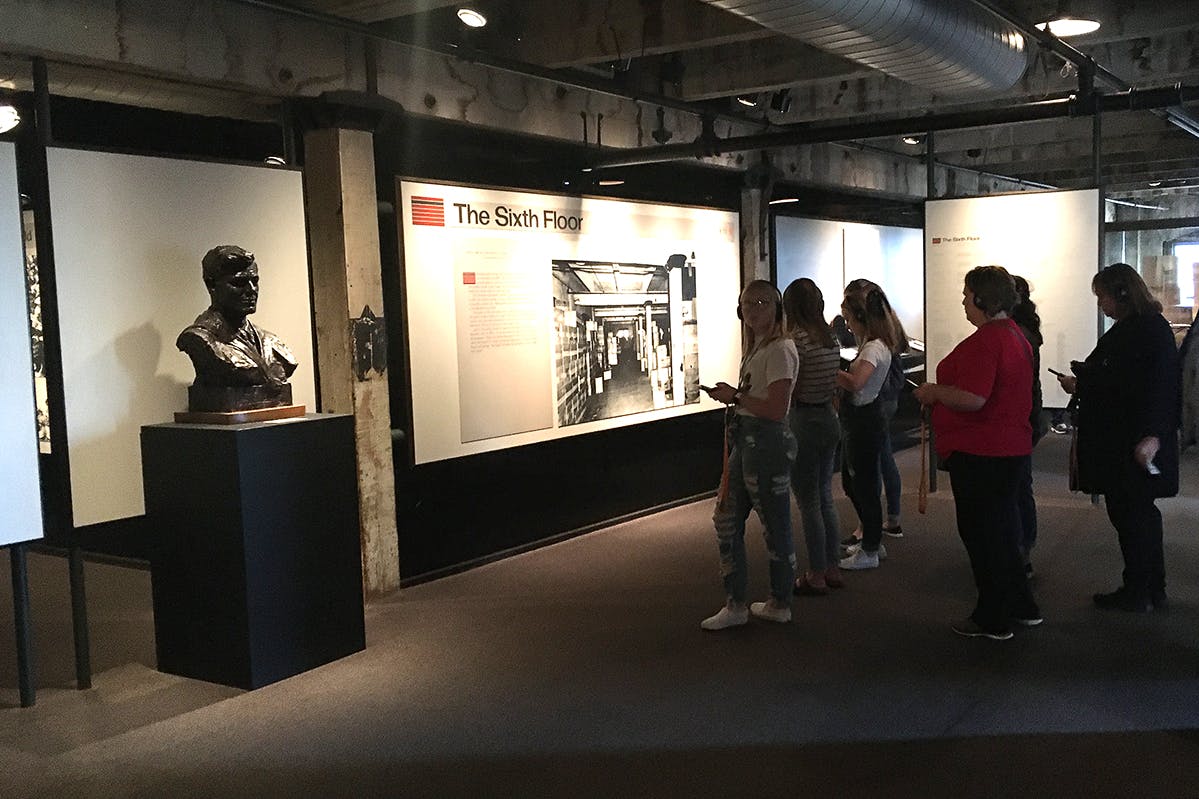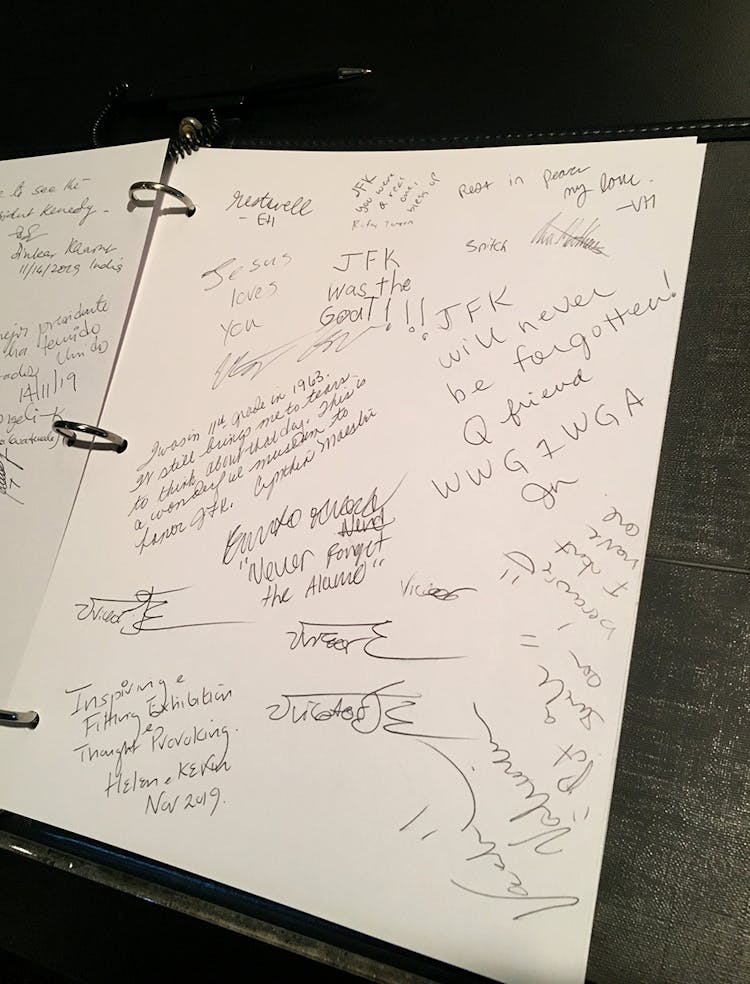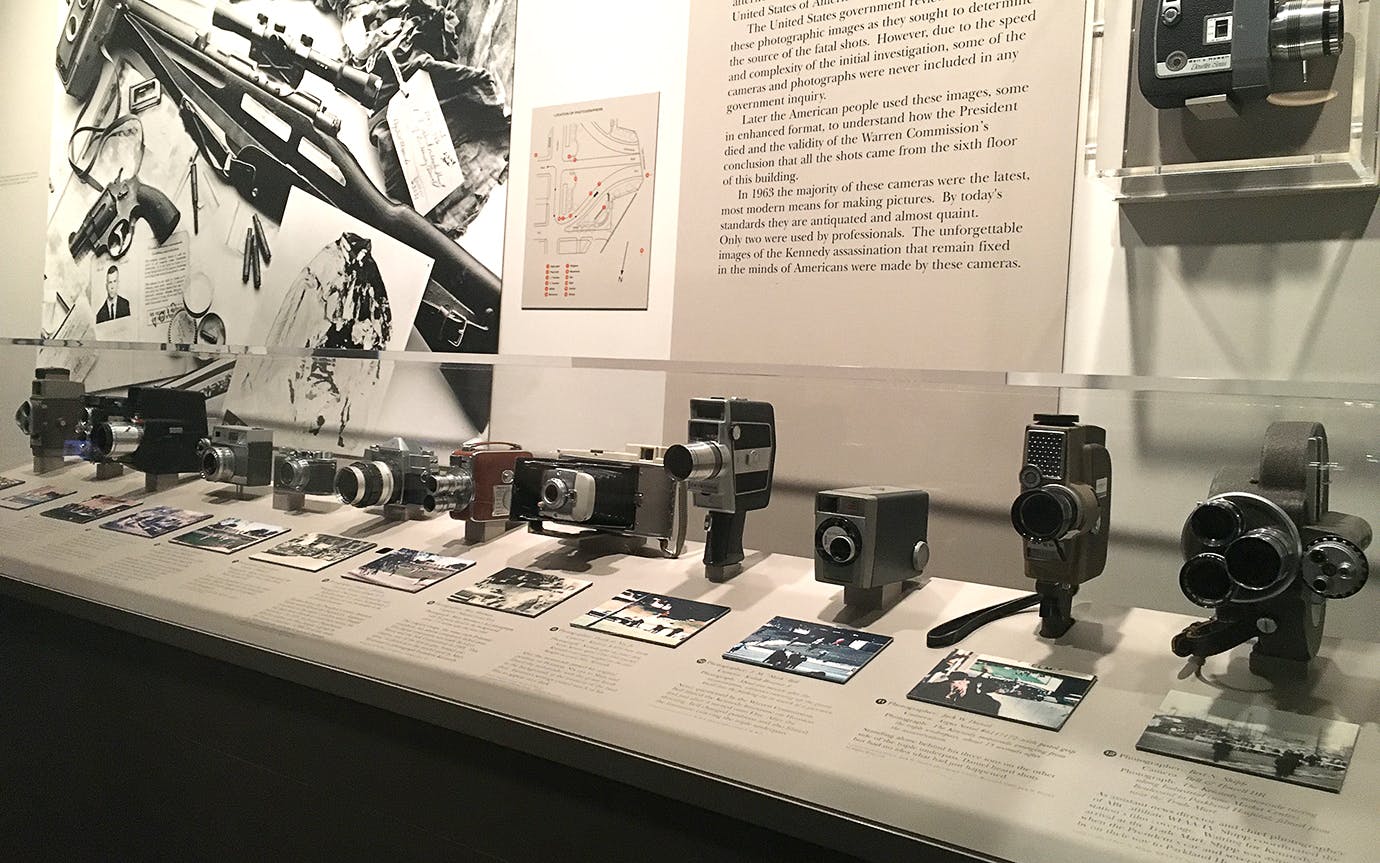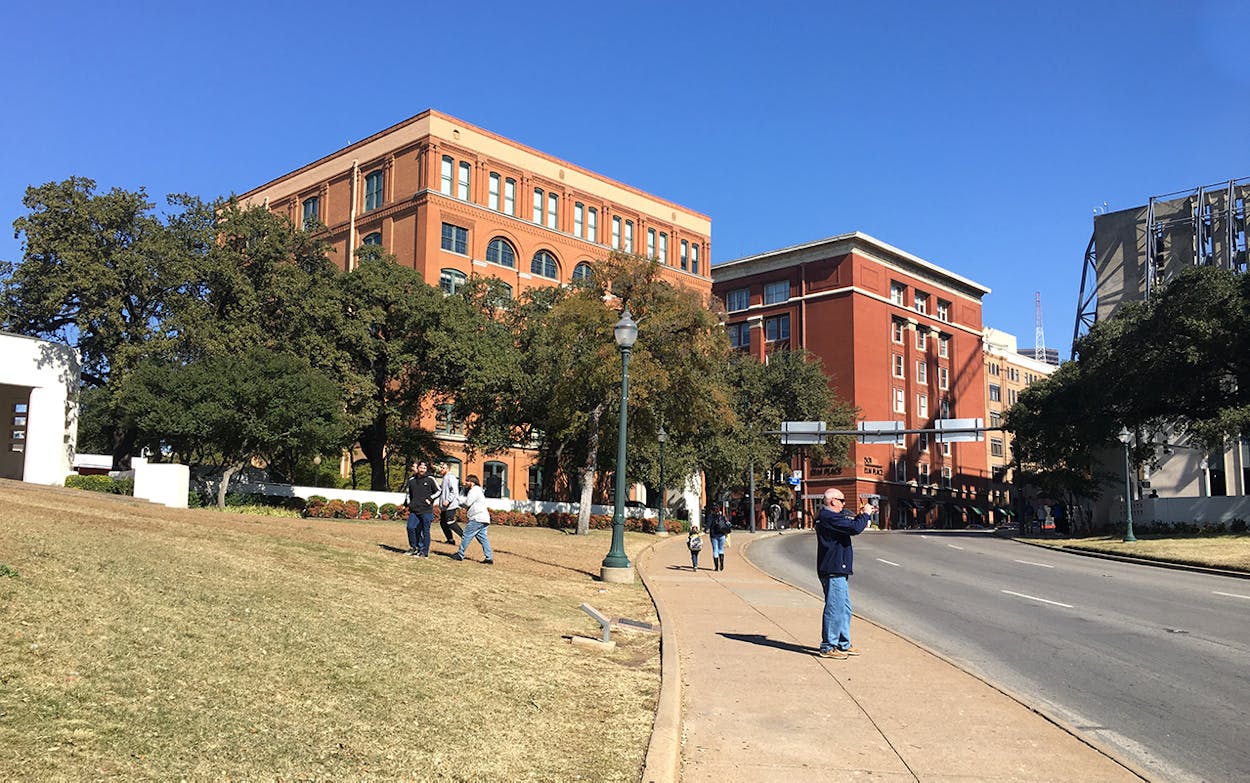The three men position themselves along the edge of Dealey Plaza, glancing up Elm Street, trying to time the traffic. This isn’t easy. Elm slopes downhill, and while local drivers know what to expect as they pass through the intersection at Houston Street, their cars nevertheless tend to accelerate as they approach the triple underpass near the western edge of downtown Dallas.
Finally, there is a lull in the traffic, and the men sprint into the street, moving as briskly as their stiff-looking boots will allow, with their hands reflexively holding onto the brims of their Stetsons. One of them breaks off from the pack, readying his phone. The other two plant themselves on the large X that has been crudely affixed to the middle lane with reflective tape. There’s some debate about its accuracy; the X moves a little whenever the road is repaved, replaced each time by still-mysterious sources. But it supposedly marks the precise spot where President John F. Kennedy was hit by a fatal headshot on a sunny November day much like this one. With the faded red-brick building of the former Texas School Book Depository stationed picturesquely behind them, the two men position their feet on either side of the X, and throw their arms around each other’s shoulders. As their friend snaps away, they smile.
It’s a grim yet familiar scene, one that plays out many times per day here—like Dallas’s own morbid version of Abbey Road. Like Abbey Road, you can even watch the spot via a live-streaming webcam, stashed inside the so-called “sniper’s perch” on the old depository’s sixth floor, from which Lee Harvey Oswald fired on Kennedy’s motorcade as it passed by on the street below. It remains preserved behind a thick pane of plexiglass as the centerpiece of the Sixth Floor Museum, where people have been coming since 1989 to revisit one of the darkest days in American history—November 22, 1963.
A fifteen-minute documentary commemorating the museum’s thirtieth anniversary plays on a loop near the exit. There is a slight air of defensiveness to this celebration, which is understandable. As museum curator Stephen Fagin explains in the video, a lot of people once regarded this blockish, unremarkable building at 411 Elm St. as the “looming manifestation of evil.” When the Texas School Book Depository Company finally moved out in 1970, there were numerous calls to raze it to the ground, some of them led by prominent Dallasites like Tom Landry, Mary Kay Ash, and Ross Perot. Instead, its owner, oilman D. Harold Byrd, sold it to country music producer Aubrey Mayhew, an opportunistic Kennedy “collector” who hoped to turn it into a shrine to the late president. Mayhew failed to find backers or attract much more than outrage. When the bank foreclosed on the building in 1972, Byrd bought it back via an auction in which he was the only bidder. An arsonist set fire to the building that same year. It stood empty once more until 1977, when it was purchased by Dallas County and converted into administrative offices. In 1984, as plans for a museum were once more ramping up, an arsonist struck again. There were many, it seemed, who simply wished it would disappear.

Yet even as the former depository became a symbolic flashpoint for Dallas’s anger and shame, visitors from all over the world continued to pilgrimage to Dealey Plaza. Some brought flowers and photos. Others simply came to gawk. Their persistence and curiosity convinced the museum’s champions—chiefly Dallas County public works director Judson Shook, preservationist Lindalyn Adams, and historian Conover Hunt—to spend more than twelve years fighting to save the building, convinced that the city had a responsibility to turn it into something that could confront the tragedy, honestly and tastefully. Besides, as Shook remarks in the film, tearing it down would only confirm suspicions that Dallas had something to hide.
It’s been three decades since the Sixth Floor Museum opened, a longer timespan than the one separating its birth from the tragedy it memorializes. Today, little controversy remains. Dallas has moved on, if not exactly embracing its role, then learning to roll with it. In 2013, Dealey Plaza hosted an official ceremony to mark the fiftieth anniversary of JFK’s assassination. Whatever repressed feelings still lingered were surely exorcised then—if not way back in 1991, when Oliver Stone commandeered downtown to film JFK, restoring Dealey Plaza to its 1963 vintage so he could kill the president over and over again. In the words of the late councilman Al Lipscomb, allowing Stone to drag those ghosts back out into the street was “a good therapeutic enema … a purge to make sure there will be no residue of the past.”
What was left behind is largely what the museum’s founders envisioned: a dignified, borderline-clinical examination of the life and murder of John F. Kennedy, inside the very walls where the latter was carried out. (Opinions about exactly what happened vary. Out in the plaza, you can still find plenty of card tables laden with literature that will tell you a story very different than the Warren Commission’s.) The Sixth Floor is a hushed and somber space, partly due to the fact that practically every visitor is plugged into a headset, listening as former WFAA reporter and assassination witness Pierce Allman guides them along walls of photographs and large, text-filled placards.


Video displays and newspaper reproductions give a sense of the turmoil that colored his trip to Texas, before a snaking path of stills from the infamous Zapruder film kick off a near millisecond-by-millisecond breakdown of the assassination and its aftermath. These are rendered safe for family viewing—no fatal headshots here—and the facts of the subsequent investigation are delivered cleanly and succinctly. The lingering questions of conspiracy are handled with similar detachment, theories of CIA and Mafia involvement laid out matter-of-factly on a pair of murals near the exhibit’s end, finally concluding with a shrug only that the discussion continues.
There’s little in the way of actual artifacts here. Anything of genuine interest was locked away inside the National Archives long ago. You will find Jack Ruby’s gray fedora, right next to the tan suit, cowboy hat, and handcuffs that belonged to the late Jim Leavelle, the detective who was escorting Oswald on the day Ruby shot him. Around the corner is the camera that the Dallas Times Herald’s Bob Jackson used to capture Oswald’s murder for his Pulitzer-winning photograph. Nearby is another row of cameras, acquired from various Dealey Plaza eyewitnesses, each paired with the pictures they took. But undoubtedly the most famous camera of all, Abraham Zapruder’s, is represented by a copy. There’s something surreal about this, as is the fact that one of the museum’s main attractions is the large-scale model of Dealey Plaza that was used by the Warren Commission—a replica of the very place you’re standing in.
Even the “sniper’s perch” is a re-creation. The space it occupies is real, as are the scuffs visible on the original floorboards. But both it and the corner staircase, where the now-infamous Mannlicher-Carcano rifle was discovered, are staged with cardboard boxes standing in for the ones that were taken away decades ago by the FBI. The infamous window, where Oswald is said to have fired that rifle, is just a facsimile, the original having been carved from the wall at some point during the building’s long dormancy. (Whether it was by Byrd or Mayhew remains a hot topic of debate and, occasionally, contested auction.) Its neighboring windows overlooking the plaza have all been fitted with interactive touchscreens, on which CGI models of the motorcade amble down Elm St. in an endless loop, Kennedy et al. reduced to pleasantly featureless avatars.
On the headset, Allman explains that these things have been painstakingly arranged so that visitors can make a “powerful connection with this building and its history.” But doing so requires breaking through several layers of artifice.

In many ways, the museum suits a man who was shrouded in myth in life, and in death even more so. What Norman Mailer once characterized as the “elusive detachment… of a man who was not quite real to himself,” an aloofness that allowed Kennedy to “capture the secret imagination of a people,” gave way to the fairy-tale mystique of Camelot, nurtured by the young president’s shrewd manipulation of television. His assassination was TV as well, the flood of information and images across those three days in November blurring the lines between news and narrative, and creating a gulf of understanding that quickly calcified into mistrust. That suspicion has since echoed across hundreds of books, films, Broadway musicals, and internet rabbit holes. The ambient paranoia it created is woven into the fabric of American life.
I’m as guilty as anyone of buying into this mythos. I was a “JFK assassination buff” from an early age, a fascination that began with a sixth-grade report on the Warren Commission. My mother, a former Fort Worth Star-Telegram reporter, was friendly with the late Jim Marrs, whose 1989 book, Crossfire: The Plot That Killed Kennedy, became a partial basis for Oliver Stone’s film. She took me to one of Marrs’s presentations—an abridged version of the conspiracy theories he’d been lecturing on at the University of Texas at Arlington since 1970—and I was hooked instantly. I had her take me to JFK on opening night (alas, I couldn’t convince her to let me skip school so we could watch Stone film the motorcade). I spent much of my adolescence thereafter carrying around books like Best Evidence and On The Trail of the Assassins, becoming intimately familiar with assassination “characters” like “Umbrella Man” and “Babushka Lady.” Were it not for my discovery of punk rock, I might have grown up to be the obsessive nerd in Richard Linklater’s Slacker, still haranguing casual acquaintances about Lee Harvey Oswald’s breakfast.
Looking back now, it’s easy to see how closely my dark enthusiasms dovetailed with the timeless teenage rite of passage of deciding that everything is bullshit. In signing my copy of Crossfire, Marrs wrote, “Always Question Authority!” —probably a stock line for him, though it felt to me like a mandate, handed down from one subversive to another. Of course, the fact that Dealey Plaza was so close to my hometown of Arlington played a major role in fostering my ghoulish pastime. On our way back from a Dallas Sidekicks games at Reunion Arena, I always got a perverse thrill passing by the old depository building, instinctively glancing up to that permanently half-open window, then quickly over to the grassy knoll, as though the mystery would reveal itself to me if only I looked hard or often enough. Again, the place had ceased to be real to me, transformed through Stone’s intoxicating pastiche and X-Files folklore into something more akin to a movie set. Even revisiting the museum today, as my GPS instructs me to turn from Houston onto Elm, my brain still fills in the rest with bits of Kevin Costner’s climactic courtroom monologue in JFK: It’s gonna be a turkey shoot.
Returning to the museum now, I intended to reckon with the fact that I once treated a man’s gruesome death as something like a hobby, and Dealey Plaza like my own personal Universal Studios. But I found that whatever connection I hoped to make, or profound truth I thought I might discover, only seemed further obfuscated, not just by time but intent. With its CGI re-creations and webcam, the virtual reality aspect of it all felt even more pronounced.
At the museum cafe across the street, I found tourists eating ice cream cones beneath a slideshow of Oswald’s arrest. In the attached gift shop, you can get a signed print of Jackson’s infamous photo of Ruby shooting Oswald for $250, one of the pricier items from a bounty of merchandise that includes Texas School Book Depository-shaped keychains and refrigerator magnets. Here as it has everywhere, the JFK assassination has grown as an industry. Even the conspiracy theories have become something of a lifestyle, evidenced in the messages from QAnon believers I find scrawled in the museum’s memory books.
The Sixth Floor isn’t to blame for this, of course, any more than the city of Dallas is for Kennedy’s death. It has made the best of its unthinkable situation, responding with an admirably positive attempt to educate, rather than titillate. On the day I visit, the museum is packed with people of all ages and nationalities: high schoolers on field trips, European tourists, a couple of zombified parents pushing strollers. They continue to be drawn here to learn not only about Kennedy’s death but his legacy, and in those same guestbooks (next to the jokers who have scribbled, “The mob did it!”), you’ll find earnest testimonials in looping cursive from kids who seem to have just now discovered Kennedy’s role in the space race and the civil rights movement. In this, the museum has clearly succeeded in its goal of crafting a memorial to the man, not his murderer.
That said, it’s jarring to see just how much separation it’s created from the very space it occupies, a distance that has only grown since 1989. Visiting there again after so many years away, I found myself wondering how it—and I, once upon a time—might have benefited from it remaining dusty and abandoned, allowing you to confront just how scarily ordinary it must have been for Oswald (or some other mortal) to fire a gun out of those windows and topple a kingdom. Maybe whatever the site lost in dark appeal, it might have gained in cathartic truth. But perhaps we can only comprehend the mythos this way, through layers of Plexiglass and X-es in the street. It’s truly history now, with all the comfort the distance of time allows.
Just before I head for the exit, I watch a man posing by that sealed-off corner staircase, positioning himself just-so next to the replica of the rifle believed to have altered America forever. As his wife readies the camera, the man points to it and smiles. What else is he supposed to do?
- More About:
- Texas History
- JFK Assassination
- Lee Harvey Oswald
- JFK
- Dallas






